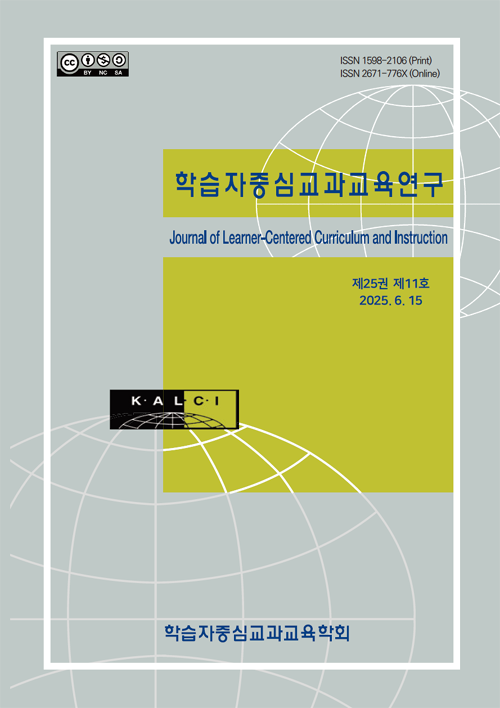- 영문명
- An Evaluation of Learner-Centered Technology Integration in Higher Education: A Critical Literature Review
- 발행기관
- 학습자중심교과교육학회
- 저자명
- 최서희(Seohee Choi) Neal Dreamson 김영진(Yeongjin Kim)
- 간행물 정보
- 『학습자중심교과교육연구』제25권 11호, 989~1005쪽, 전체 17쪽
- 주제분류
- 사회과학 > 교육학
- 파일형태
- 발행일자
- 2025.06.15

국문 초록
목적 본 연구는 고등교육 환경에서 교수자들이 학습자중심 테크놀로지 통합교육을 효과적으로 실현할 수 있도록, 비판적 문헌 분석을 통해 기존의 테크놀로지 통합모델을 평가하고, 교수 지원 프로그램의 평가 체계 확립을 위한 방향을 제시하고자 한다.
방법 본 연구는 학습자중심 테크놀로지 통합교육의 개념을 정립하고, 이를 평가하기 위한 TIM(The Technology Integration Matrix) 모델을 활용하여 국내 고등교육 현장에서의 사례를 분석하였다. KCI 데이터베이스를 활용하여 3차례에 걸친 분류 및 분석 작업을 통해 고등교육 학습자중심 테크놀로지 통합교육 관련 논문을 총 16편을 선정하였으며, TIM 모델이 제시한 다섯 가지 테크놀로지 통합 수준과 다섯 가지 학습환경 형태를 평가하였다.
결과 대부분의 사례는 테크놀로지 통합의 도입 또는 차용 수준에 머물러 있었고, 여전히 교수자 중심의 지식 전달 도구로 한정되어 있어 최상위 수준인 변혁적 테크놀로지 통합과 거리가 있었다.
결론 이를 극복하기 위한 대안으로 교수자는 고차원 학습 활동을 가능하게 하는 학습 목표 설정, 자기주도적 학습 환경 설계, 과정중심 평가 도입, 그리고 체계적인 LMS 활용 방안의 필요성을 제안한다. 또한 강의계획서에 테크놀로지 통합 계획과 전략을 포함하여 수업 단위에서 진정한 학습자중심교육의 실현을 제안한다.
영문 초록
Objectives This study aims to enhance the quality of learner-centeredness in higher education by critically analyzing technology integration models and developing an evaluation framework for faculty support programs. Through the analysis and framework, the study seeks to provide strategic directions for effectively implementing learner-centered technology integrated education.
Methods This study argues for learner-centered technology integration education and analyzes its practical application in Korean higher education using the Technology Integration Matrix (TIM) model. A total of 16 studies related to learner-centered technology integration education in higher education were selected from the KCI database after the three stages of a sorting process. These studies were evaluated based on the five levels of the technology integration and the five characteristics of the learning environments defined by the TIM model.
Results The results revealed that most cases remained at the entry or adoption levels of technology integration, still confined to teacher-centered tools for knowledge transmission, and fell short of achieving the transformative level of technology integration.
Conclusions To address these limitations, this study proposes alternatives such as setting learning objectives that enable higher-order learning activities, designing self-directed learning environments, implementing process-oriented assessments, and adopting systematic approaches to utilizing Learning Management Systems (LMS). Furthermore, it recommends incorporating technology integration plans and strategies into course syllabi, thereby facilitating authentic learner-centered education at a course level.
목차
Ⅰ. 서론
Ⅱ. 이론적 배경
Ⅲ. 연구 방법
Ⅳ. 연구 결과
Ⅴ. 결론 및 제언
참고문헌
키워드
해당간행물 수록 논문
참고문헌
최근 이용한 논문
교보eBook 첫 방문을 환영 합니다!

신규가입 혜택 지급이 완료 되었습니다.
바로 사용 가능한 교보e캐시 1,000원 (유효기간 7일)
지금 바로 교보eBook의 다양한 콘텐츠를 이용해 보세요!


